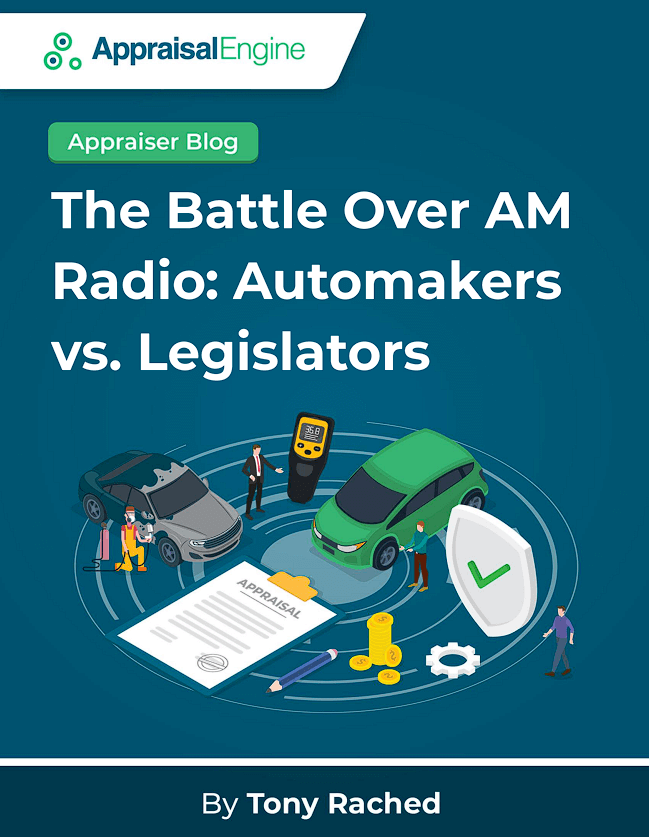The Battle Over AM Radio: Automakers vs. Legislators (PDF)
In today’s rapidly advancing technological landscape, a once-revered medium finds itself caught in the crossfire. AM radio, once a staple of American life, now faces a contentious debate between automakers seeking to remove it from vehicles and federal legislators emphasizing its critical role in emergency alerts during crises.

Prominent automakers such as BMW, Mazda, Polestar, Rivian, Tesla, Volkswagen, and Volvo have chosen not to include broadcast AM radio in their electric vehicle (EV) models. They argue that the electromagnetic interference caused by the EV motor system disrupts the AM radio signal, leading to an undesirable ticking sound. Shockingly, about one-third of all newly available EV models in the United States in 2023 lack an AM tuner, according to SBD Automotive, a leading global automotive technology research firm.
So why are automakers abandoning this long-standing technology? The answer lies in their pursuit of cost reduction, complexity reduction, and improved EV efficiency, even if only incremental. Faced with intense competition and the challenge of making profits from EVs priced below $70,000, automakers are striving to trim expenses wherever possible. Additionally, they point out that new-car buyers show minimal interest in AM radio usage.
The addition of an AM tuner to a vehicle’s bill of materials can cost anywhere between $20 and $30, as estimated by SBD Automotive. Consequently, automakers are eager to cut costs and redirect resources toward developing new EV models and driver-assist technology. In their quest for financial efficiency, they are determined to leave no stone unturned.
Despite the ongoing debate, the future of AM radio hangs in the balance, with no clear resolution in sight. The Federal Emergency Management Agency (FEMA) recognizes the critical role of AM radio in emergency communication. By equipping certain radio stations, predominantly AM, with backup equipment and power generators, FEMA ensures that emergency alerts can be broadcasted “under all conditions,” even when other communication channels fail.
The significance of AM radio in emergency situations has prompted legislators to introduce a bill that would make it mandatory for vehicles to include AM radio. The aim is to ensure that drivers have access to reliable emergency alert systems, considering that AM radio currently reaches around 45 million listeners per month in the United States, as reported by Nielsen ratings. The fate of AM radio hangs in the balance as the industry, legislators, and public debate its importance and future relevance.
Under mounting governmental pressure, Ford Motor Co. recently announced its decision to retain AM radio in its 2024 Ford and Lincoln EV models. Furthermore, they will restore AM radio functionality via software updates for the 2023 vehicles that still possess the necessary hardware. Notably, Ford had initially removed AM radio even from a combustion vehicle, the 2024 Mustang.
Surprisingly, less than 5 percent of Ford’s connected-car users actively listen to AM radio.
The Technical Dilemma
In December 2022, Senator Ed Markey, a Massachusetts Democrat, sent inquiries to 20 automakers regarding their provision of free AM or FM broadcast radio, their intentions to discontinue these features, and their offering of digital broadcast radio. Senator Markey emphasized the significance of AM/FM radio as the most dependable, cost-free, and accessible communication mechanism for public officials during emergencies.
Several automakers, including Tesla, stated that the electric drivetrain design creates “significant interference to AM radio transmissions.” Jan Becker, the founder and CEO of Apex.AI, a company specializing in mobility software, explained that the electromagnetic field generated by the battery-powered motor is the source of interference. The inverter in the system continuously switches the current between different coils, altering the electromagnetic field, which in turn operates the motor. This modulation process aligns with the principle behind AM radio waves, resulting in conflicting systems.
While combustion engines also generate interference, it occurs on a smaller scale. Automakers have incorporated components into both powertrains to mitigate this interference, but it inevitably impacts the efficiency of the motor system. In the case of battery-electric motors, the interference is more pronounced and necessitates greater suppression efforts. Although these suppressions slightly reduce the motor system’s efficiency, Becker asserts that it represents a design compromise.
Despite Senator Markey’s inquiry, General Motors and Mercedes-Benz did not provide a direct response. Instead, they referred to the Alliance for Automotive Innovation, an industry trade group, which emphasized the need for ongoing modernization of the emergency alert system.
Stellantis, on the other hand, responded that they have not announced any plans to eliminate AM or FM radio from their vehicles sold in the United States. They continue to offer both as standard features across their product range. Volkswagen acknowledged exploring various solutions to reduce interference but concluded that none of them proved effective or practical. Additionally, they stated that their EV customers have not expressed a demand for AM radios in their vehicles.
The Broad Impact
The Integrated Public Alert and Warning System, managed by the government, consists of two components. The first utilizes private-sector radio and television stations, as well as cellphones, to distribute emergency messages such as Amber Alerts. The second component, known as the National Public Warning System, relies on 77 radio stations, 62 of which are AM, supported by FEMA.
While FM radio stations generally provide better sound quality than AM stations, the latter possesses a wider reach due to its longer wavelength and ability to bounce off the ionosphere, particularly at night. Moreover, AM radio waves can penetrate solid objects like mountains, making them more reliable in certain scenarios compared to FM. Additionally, AM radio infrastructure requires less equipment than television, while internet access and cell service availability vary by location.
During emergencies, radio emerges as the least fragile medium. As long as radio stations possess backup power generators, they can continue operating for extended periods. Surprisingly, most households still own a radio, ensuring the presence of a communication channel even when other means fail.
In rural areas, FM reception may be limited, leaving drivers to rely on AM signals for important updates. An example of this is WRDN Radio in Wisconsin, where owner Brian Winnekins produces a show, especially for farmers from 5 to 7 am. To assist households that were struggling with Wi-Fi access during the onset of the pandemic, WRDN even extended their broadcasts an extra hour to include educational announcements. With this gesture, they aided children in staying connected to their studies while times were hard.
Representative Josh Gottheimer, a Democrat from New Jersey, is leading the charge for the AM for Every Vehicle Act in the House of Representatives. This crucial legislation aims to require the National Highway Traffic Safety Administration (NHTSA) to make AM broadcast radio a standard feature in vehicles, without any extra cost to consumers. Garnering support from both sides of the aisle, the bill has gained bipartisan momentum in the Senate, with Senator Markey and Senator Ted Cruz of Texas spearheading the cause. These lawmakers recognize the significance of AM radio and its accessibility for drivers across the nation.
On June 6, the House’s Subcommittee on Communications and Technology scheduled a hearing to delve deeper into this matter. The outcome of these deliberations will shape the future of AM radio and its place in the vehicles of tomorrow. As the battle unfolds, the importance of emergency alert systems and the resilience of this decades-old technology take center stage.





